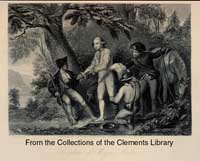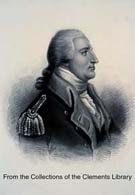| John André
(1750-1780)
John André was the aide de camp of Sir Henry Clinton, the British commander-in-chief. André purchased a commission as second lieutenant in the Royal Welsh Fusiliers in 1771. In 1774 he joined a regiment in Quebec, where he pursued his first love of poetry and painting. In September and October 1775, American troops laid siege to his fort at St. Johns. He was captured, brought back to Lancaster, Pennsylvania, and treated roughly. His days as a prisoner turned him against the American rebels. The Americans finally exchanged him in 1776, and he met up with British troops in New York City. Sir William Howe was especially interested in the information André had learned behind the American lines. André then purchased a position as captain and become General Charles Grey's aide. He became known for behaving ruthlessly and aggressively on the battlefield. In 1778 André joined the staff of Henry Clinton, General Howe's replacement. Clinton made him head of intelligence in April 1779. André successfully kept track of intelligence from American disserters and British prisoners who had escaped or were exchanged. André's most famous success was the treachery of Benedict Arnold. As a result, Clinton promoted André rapidly, from deputy to adjutant general in October 1779. Yet Benedict Arnold was also André's downfall. Three American militiamen captured André, who was dressed in civilian clothes with a treasonous letter from Clinton to Arnold in his shoe. André was tried with a court martial. Found guilty, he begged George Washington to shoot him as a gentlemen instead of hanging him as a spy. Nevertheless, he was hanged as a spy in Tappan, New York on October 2, 1780. Relevant Letters: |
 |
| Benedict Arnold
(1741-1801)
Benedict Arnold was a successful military leader early in his career, but his treasonous relationship with the British in the American Revolution marks him as an infamous traitor to the American cause. Before the Revolution, he was a well-to-do merchant. At the start of the Revolution, Arnold suggested that he could capture Fort Ticonderoga in New York. Benjamin Church made him colonel, and Arnold raised a regiment and captured the fort on May 10, 1775. He returned home victoriously and joined General George Washington's Continental Army. Washington next gave him command of an expedition to attack Quebec. Their attack on Quebec failed, but Arnold and his men managed to sustain a blockade. During this time, Arnold seriously wounded his knee. For his heroism Congress promoted him to brigadier general on January 10, 1776. In 1776 Arnold repeatedly demonstrated his military prowess against British forces. Yet, Arnold threatened to resign when other brigadiers were promoted to major generals, but not him. At the encouragement of Washington, he again joined the army to stop the advance of General Burgoyne, Colonel Barry St. Leger, and Sir William Howe from the north. Arnold twice made two heroic attacks (once independently) against the British, leading to Burgoyne's surrender at Saratoga on October 17, 1776. During these forays, he was shot in the same leg as before, giving him a serious limp thereafter. Arnold's successes conflicted with his superior, General Horatio Gates, and he was temporality removed from his command. |
 |
| In 1778 Washington appointed Arnold the military commander
of Philadelphia after the British evacuated. In Philadelphia patriots
accused him of using using public wagons for private profit and for making
money for himself after he closed all the shops down in Philadelphia.
Patriots also accused him of being to friendly with loyalists. After
all, the British had just evacuated Philadelphia, and tensions were high
between loyalists and patriots. Arnold then faced a court martial
for corruption and resigned his post on March 19, 1779. Soon
after resigning, Arnold sold his services to the British.
In May 1779 Arnold sent for Joseph Stansbury, who lived in Philadelphia and opposed armed resistance. Stansbury, with the help of Jonathan Odell, met with John André, the aide de camp of General Henry Clinton. In the following months, Arnold provided the British with a variety of military and political secrets. Arnold's treachery was revealed when André was captured on September 21. Arnold escaped to New York once the Americans discovered he was a spy. Arnold published a statement to encourage other Americans to join his cause. When this failed, we was made a British brigadier and sent on raids in Virginia. His successful attacks against forts in Virginia and New York permanently marked him as a traitor. After General Charles Cornwallis surrendered at Yorktown, Virginia in October 1781, Arnold and his family sailed back to England with Cornwallis. In Britain, he was not trusted with any military commands and failed as a merchant. He died in London in 1801. Relevant Letters: |
|
| Sir Henry
Clinton (1730-1838)
Henry Clinton replaced William Howe as Commander of the British forces in America in 1778. During the next four years, he disputed admirals, generals, and Secretary of State George Germain, and became known for his intelligent planning and ineffectual execution. In May 1782, several months after Yorktown, Clinton turned his command over to Sir Guy Carleton. Clinton spent most of his postwar years fighting a paper war with his enemies in the army, navy, and government. His papers, including many spy letters, intelligence reports and military maps, are housed at the Clements Library and form the basis of this exhibit. See the Sir Henry Clinton Collection for more information. Relevant Letters: |
 |
| Lafayette,
Marquis de (1754-1834)
The American Declaration of Independence inspired Lafayette to buy a ship and sail to America without official permission from France in 1777. In America, he became an unpaid volunteer on George Washington's staff. He participated in the Battle of Brandywine in 1777 and soon became a major general. While spending the winter in Valley Forge, he became close friends with Washington. He continued to have military commands in 1778, but in 1779 went back to France to advocate the American cause. He returned in 1780 bearing the news to Washington that the Comte de Rochambeau would bring French troops to assist him. Lafayette next went to Virginia, where he battled Cornwallis until Cornwallis retreated to Yorktown. After Yorktown, Lafayette was the "diplomatic aide-de-camp" to Benjamin Franklin in Paris and continued to voice American interests to the French government. Lafayette had an illustrious and tumultuous political career in France during the French Revolution, the Reign of Terror, Napoleon, and the Restoration Era, throughout which he defended his concept of liberty. |
| Jonathan Odell
Rev. Jonathan Odell, graduate of Princeton and grandson of its first president, was a physician, poet, and clergyman. He went over to the British side in 1777, and patriots promptly confiscated his property in New Jersey. Odell probably helped arrange the first meeting between Benedict Arnold and Joseph Stansbury in New York in May 1779. He also translated the secret ciphers and decoded the invisible ink of the spy letters passing among John André, Joseph Stansbury, and Benedict Arnold. Relevant Letters: |
| Paul Revere
(1735-1818)
Paul Revere was one of the finest American craftsmen of the late eighteenth century. He learned his trade of silversmithing from his father. Revere served as an officer in the Seven Years War and then returned to Boston to set up shop as a silversmith. He was a leader in the Bostonian Sons of Liberty and played in a major role in popularizing resistance to the Stamp Act and the Boston Massacre through his widely circulated engravings. He helped plan and carry out the Boston Tea Party in 1775. He also served as a courier between the American rebel organizations. On April 18 and 19 of 1775, he set out on horseback from Boston to warn patriot leaders John Hancock and Sam Adams in Lexington that the British were marching to seize rebel leaders and weapons. During the war he served the American cause as a manufacturer of gunpowder and as an engraver for Congress. After the war he returned to his business as a silversmith and engraver. Relevant Letters: |
| Joseph
Stansbury
Joseph Stansbury was born in London, but he lived in Philadelphia during the Revolution. When the British occupied Philadelphia, he was in British favor. He served as the commissioner of the city watch, managed General Howe's lottery for the relief of the poor, and directed the library. He directly opposed armed resistance and independence from the British. When the British withdrew to New York in June 1778, he stayed in Philadelphia. He then served as the main intercessory between Benedict Arnold and John André. After Arnold approached him with overtures to the British cause, he ventured to New York specifically to meet with André about Arnold. Relevant Letters: |
| Benjamin
Tallmadge (1754-1835)
With Benjamin Tallmadge's leadership, George Washington was able to create a strong and successful chain of spies throughout the New York area, beginning the secret service in America. These agents, primarily the Culper Gang, gathered countless amounts of information for Washington, which greatly aided in winning the war. Tallmadge was born in Setauket, Long Island. He was an extremely bright boy, who went to Yale University at the age fifteen. After school he began a teaching career and soon became a headmaster of a school in Wethersfield, CT. When war broke out Tallmadge became interested and decided to join. He began his army career as 1st lieutenant in Colonel John Chester's Regiment of Wadsworth's Connecticut Brigade, and eventually rose up the ladder to become Brigade Major and then captain of a troop in the 2nd Continental Light Dragoon Regiment. In the summer of 1778 his dragoons were assigned under Brigadier General Charles Scott, who was Washington's intelligence chief. Tallmadge's new job was to recruit intelligence sources throughout the Connecticut and New York area. He contacted old friends from Long Island and New York City, gradually forming the Culper ring. When Charles Scott had to go home because of family problems in the Fall of 1778, Tallmadge was promoted once again and began to report directly to Washington. Tallmadge is now remembered as one of the founders of the first organized espionage operations in America. After his successful career during the war, he was elected to Congress, where he served eight terms. Relevant Letters: |
![]()
Letters | Stories | Methods | People | Routes | Timeline | Home
Clements Library | Sir Henry Clinton Collection | Teachers' Lounge | About the Project | Bibliography